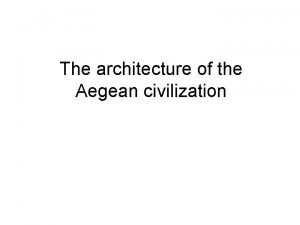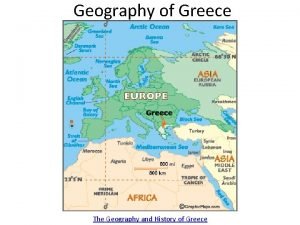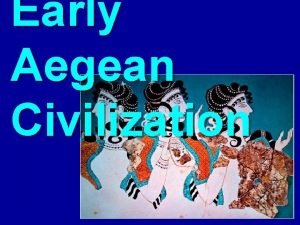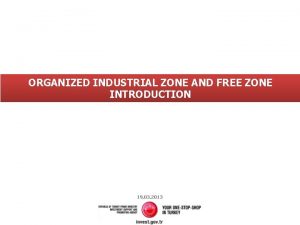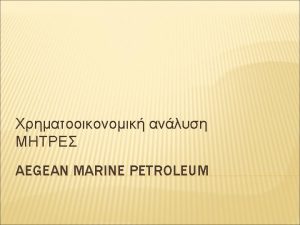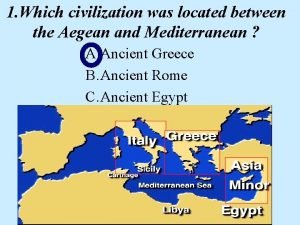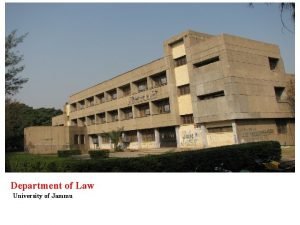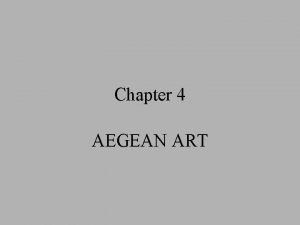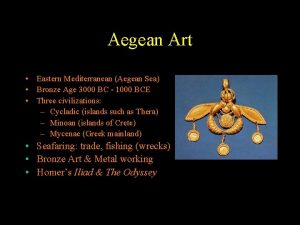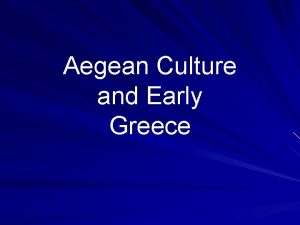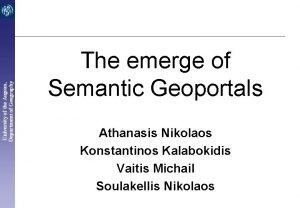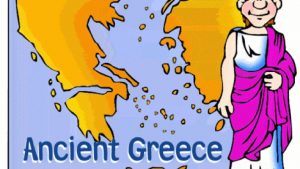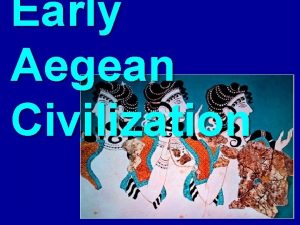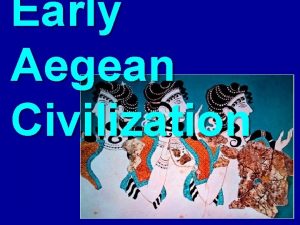Department of Geography University of the Aegean https
















- Slides: 16

Department of Geography University of the Aegean https: //geography. aegean. gr/index. php Department of Geography University of the Aegean Sustainable Landscapes Research Seminar: Actors, Drivers and Landscape change Thanasis Kizos

University of the Aegean Department of Geography Presentation Outline 3 parts – 3 papers: • (a) Conceptual framework for drivers – actors - changes: research approaches, scale, methods and results; • (b) The driving forces of landscape change in Europe: A systematic review of the evidence; • (c) Biocultural diversity in landscapes and “place-based food networks”: from the large to the small scale.

University of the Aegean Department of Geography (Supra)national scale Temporal scale Regional scale s Case study scale ce r o f g Drivin Actors/ Institutions La ng a h c nd e Spatial scale

D-F-C models, aims and scale University of the Aegean Department of Geography Study aim Conceptual models Driving force Land change (DF-C) Driving force/Actor Land change (DFA-C) Small region National Supranational • Generation of hypothesis • Estimation of parameters for theoretical • Understanding causal chain driving forces - Case study analysis of landscape history and driving factors of past and current landscape change (Case A) actors-change • Identifying specific combinations of driving forces and actors that lead to change • Interactions among actors and drivers of land change, including feedbacks • Policy analysis and intervention • Actor behavior and decision-making resulting Actor - Land change (A-C) Case study • Exploration models Driving force Actor - Land change (DF-A-C) Scale of analysis in land change • Interactions among actors of land change, including feedbacks • Policy analysis and intervention • Social learning • Raising awareness and stewardship options Transdisciplinary (Case C) discussions • Evaluation of aimed at landscape values developing stewardship of (Case D) • Agent-based modeling cultural landscapes of landscape change (Case B) Synthesis and metaanalysis Decision support for informed policy (Case E)

University of the Aegean Department of Geography D-F-C models, aims and scale II • “Portfolio approach” in a landscape with research questions related to different aspects of human-environment interactions. • Some approaches work better together: DFC with DF-A-C approaches. A-C with DFA-C models. • Selection of slightly different sets of actors (e. g. , farmers, non-farmer residents, younger-older residents, culturally driven land managers, administrators) yielded different prioritization of the driving forces of these changes. • How actors rationalize causal chains of drivers and responses: for broader changes, respondents focused on more abstract drivers (e. g. “the olive oil market” or “the CAP”), but when questioned about their choices, more personal and local factors were mentioned.

University of the Aegean Department of Geography D-F-C models, aims and scale III • Land change and landscape studies evolve. Need to move from a single case study and one research method approach to cross-site analyses (rise of metastudies). • Need for plurality of research approaches and underlying conceptualizations of human -environment interactions that can encompass the full complexity of land-use developments. • Need to integrate quantitative and qualitative approaches and data • What are we to do with “big data”?

University of the Aegean Department of Geography Meta-analysis of landscape change

University of the Aegean Department of Geography Meta-analysis of landscape change

University of the Aegean Department of Geography Meta-analysis of landscape change

University of the Aegean Department of Geography Meta-analysis of landscape change • Research on landscape change drivers is diverse, covering multiple disciplines, methods, as well as spatial and temporal scales; • Research tendencies: neglect of remote and economically marginal areas, focus on urban and peri-urban, fewer studies on landscape stability- persistence; • Land abandonment is the most prominent among multiple proximate drivers of landscape change in Europe, in particular in the Mediterranean and Eastern Europe; • Combinations of underlying drivers are determining landscape change, rather than single key drivers. • The way forward: expansion of scope of studies; improvement of conceptual clarity of role and identification of actors vs. driving forces; more robust tools and methods to quantitatively assess causalityof landscape change; design of multi-scale studies

University of the Aegean Department of Geography Biocultural diversity in landscapes and “place-based food networks” • Landscape as a place of production • Place-based food networks: networks of producers, consumers, and other actors that embody alternatives to the more standardized industrial mode of food supply. Developed as a response to the expansion of globalized agri-food supply chains that increase distance between consumption of food and the landscapes of food production. • Biocultural diversity: ‘‘conservation actions made in the service of sustaining the biophysical and socio-cultural components of dynamic, interacting, and interdependent social–ecological systems’’. It involves the ‘‘diversity of life in all its manifestations—biological, cultural, and linguistic—which are interrelated (and likely co-evolved) within a complex socio-ecological system’’ (Buizer et al. 2016, p. 4).

University of the Aegean Department of Geography Biocultural diversity in landscapes and “place-based food networks” II • Links between place-based food networks and landscapes through biocultural diversity: • (a) producer–consumer relationships: from ‘‘Prosumers’’ to conventional chains; • (b) places of and flows between production and consumption (geographical and symbolic distance between production and consumption); and • (c) landscape outcomes (multiple social–ecological impacts of place-based food networks in landscapes).

University of the Aegean Department of Geography Biocultural diversity in landscapes and “place-based food networks” III

University of the Aegean Department of Geography Sustainable Landscapes? • Is the term “landscape” useful anymore? Too many dimensions, too many scales, too many research approaches? • Is the term “sustainable” useful anymore? How can be bridge the gap between different socio-ecological systems and their needs?

University of the Aegean Department of Geography Sustainable Landscapes? My feeling: Landscape is useful exactly because it is complex and incorporates quantities and qualities, “objective” and “subjective” dimensions, different scales, different “stakes” and stakeholders. Change and persistence very important: we need to find ways and approaches that can encompass different scales and types of data, different conceptual models.

University of the Aegean Department of Geography
 Nestor aegean
Nestor aegean Labeled ancient greece map
Labeled ancient greece map How did geography help shape greek civilization
How did geography help shape greek civilization Sophocles dover beach
Sophocles dover beach Led soldiers across hellespont into anatolia
Led soldiers across hellespont into anatolia Balkan peninsula on ancient greece map
Balkan peninsula on ancient greece map Nilufer organized industrial zone
Nilufer organized industrial zone Aegean marine petroleum network inc
Aegean marine petroleum network inc Agean art
Agean art Aegean dividend miles
Aegean dividend miles The earliest aegean civilization was located
The earliest aegean civilization was located Ap human geography political geography frq
Ap human geography political geography frq 5 themes of geography ap human geography
5 themes of geography ap human geography Proruption ap human geography
Proruption ap human geography Department of law university of jammu
Department of law university of jammu Department of geology university of dhaka
Department of geology university of dhaka Mechanicistic
Mechanicistic
